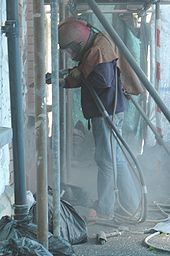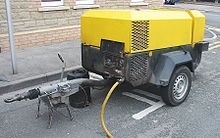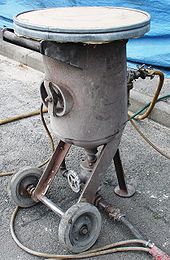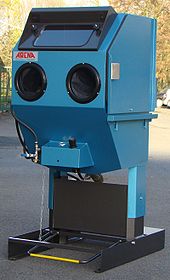- Abrasive blasting
-
 A corrosion pit on the outside wall of a pipeline at a coating defect before and after abrasive blasting.
A corrosion pit on the outside wall of a pipeline at a coating defect before and after abrasive blasting.
Abrasive blasting is the operation of forcibly propelling a stream of abrasive material against a surface under high pressure to smooth a rough surface, roughen a smooth surface, shape a surface, or remove surface contaminants. A pressurized fluid, typically air, or a centrifugal wheel is used to propel the media. The first abrasive blasting process was patented by Benjamin Chew Tilghman on October 18, 1870.[1]
There are several variants of the process, such as bead blasting, sandblasting, and sodablasting.
Contents
Types
Wet abrasive blasting
Common features include: the ability to use extremely fine, or coarse, media with densities ranging from plastic to steel; the ability to use hot water and soap to allow simultaneous degreasing and blasting; Elimination of Dust - so silicacious materials can be used without worry, hazardous material or waste can be removed without danger - e.g. removal of asbestos, radioactive, or other poisonous products from components and structures leading to effective decontamination.
The process is available in all conventional formats including hand cabinets, walk in booths, automated production machinery and total loss portable blasting units.
Process speeds can be as fast as conventional dry sand blasting when using the equivalent size and type of media. However the presence of water between the media and the substrate being processed creates a lubricating cushion that can protect both the media and the surface from excess damage. This has the dual advantage of lowering media breakdown rates and preventing impregnation of foreign materials into the surface. Hence surfaces after wet blasting are extremely clean, there is no embedded secondary contamination from the media or from previous blasting processes, and there is no static cling of dust to the blasted surface. Subsequent coating or bonding operations are always better after wet blasting than dry blasting because of the cleanliness levels achieved. The lack of surface recontamination also allows the use of single equipment for multiple blasting operations - e.g. stainless steel and carbon (mild) steel items can be processed in the same equipment with the same media without problems.
Bead blasting
Bead blasting is the process of removing surface deposits by applying fine glass beads at a high pressure without damaging the surface.
It is used to clean calcium deposits from pool tiles or any other surfaces, and removes embedded fungus and brighten grout color. It is also used in auto body work to remove paint.
Wheel blasting
In wheel blasting, a wheel uses centrifugal force to propel the abrasive against an object. It is typically categorized as an airless blasting operation because there is no propellant (gas or liquid) used. A wheel machine is a high-power, high-efficiency blasting operation with recyclable abrasive (typically steel or stainless steel shot, cut wire, grit or similar sized pellets). Specialized wheel blast machines propel plastic abrasive in a cryogenic chamber, and is usually used for deflashing plastic and rubber components. The size of the wheel blast machine, and the number and power of the wheels vary considerably depending on the parts to be blasted as well as on the expected result and efficiency. The first blast wheel was patented by Wheelabrator in 1932.[2]
Hydro-blasting
Hydro-blasting, commonly known as water blasting, is commonly used because it usually requires only one operator. In hydro-blasting, a highly pressured stream of water is used to remove old paint, chemicals, or buildup without damaging the original surface. This method is ideal for cleaning internal and external surfaces because the operator is generally able to send the stream of water into places that are difficult to reach using other methods. Another benefit of hydro-blasting is the ability to recapture and reuse the water, reducing waste and the impact on the environment.
Micro-abrasive blasting
Main article: Abrasive jet machiningMicro-abrasive blasting is dry abrasive blasting process that uses small nozzles (typically 0.25 mm to 1.5 mm diameter) to deliver a fine stream of abrasive accurately to a small part or a small area on a larger part. Generally the area to be blasted is from about 1 mm2 to only a few cm2 at most. Also known as pencil blasting, the fine jet of abrasive is accurate enough to write directly on glass and delicate enough to cut a pattern in an eggshell. The abrasive media particle sizes range from 10 micrometres up to about 150 micrometres. Higher pressures are often required.
The most common micro-abrasive blasting systems are commercial bench-mounted units consisting of a power supply and mixer, exhaust hood, nozzle and gas supply. The nozzle can be hand-held or fixture mounted for automatic operation. Either the nozzle or part can be moved in automatic operation.
Automated blasting
A fully automated blasting system usually includes contained surface preparation and coating applications.
Dry ice blasting
In this type of blasting air and dry ice are used and with the help of a huge mass and air pressure the parent material is cleaned without destroying the properties of the parent material.
Bristle Blasting
Main article: Bristle BlastingBristle Blasting is, unlike other blasting methods, a process not needing any blast media. The surface is treated by a brush-like rotary power tool made of dynamically tuned high-carbon steel wire bristles. Repeated contact of the rotating sharp bristle tips with the surface results in localized impact, rebound, and the formation of craters, thereby simultaneously cleaning and coarsening the surface.
Equipment
Portable blast equipment
Mobile dry abrasive blast systems, are typically powered by a diesel air compressor. The air compressor provides a large volumes of high pressure air to a single or multiple "blast pots". Blast pots are pressurized, tank like containers, filled with abrasive material, used to allow an adjustable amount of blasting grit into the main blasting line. The number of blast pots is dictated by the volume of air the compressor can provide. Fully equipped blast systems are often found mounted on semi-tractor trailers, offering high mobility and easy transport from site to site.others are hopper fed types making them light weight and more mobile
In wet blasting, the abrasive is introduced into a pressurized stream of water or other liquid, creating a slurry. Wet blasting is often used in applications where the minimal dust generation is desired. Portable applications may or may not recycle the abrasive.
Blast cabinet
A blast cabinet is essentially a closed loop system that allows the operator to blast the part and recycle the abrasive. It usually consists of four components; the containment (cabinet), the abrasive blasting system, the abrasive recycling system and the dust collection. The operator blasts the parts from the outside of the cabinet by placing his arms in gloves attached to glove holes on the cabinet, viewing the part through a view window, turning the blast on and off using a foot pedal or treadle. Automated blast cabinets are also used to process large quantities of the same component and may incorporate multiple blast nozzles and a part conveyance system.
There are three systems typically used in a blast cabinet. Two, siphon and pressure, are dry and one is wet:
- A siphon blast system (suction blast system) uses the compressed air to create vacuum in a chamber (known as the blast gun). The negative pressure pulls abrasive into the blast gun where the compressed air directs the abrasive through a blast nozzle. The abrasive mixture travels through a nozzle that directs the particles toward the surface or workpiece.
Nozzles come in a variety of shapes, sizes, and materials. Tungsten carbide is the liner material most often used for mineral abrasives. Silicon carbide and boron carbide nozzles are more wear resistant and are often used with harder abrasives such as aluminum oxide. Inexpensive abrasive blasting systems and smaller cabinets use ceramic nozzles.
- In a pressure blast system, the abrasive is stored in the pressure vessel then sealed. The vessel is pressurized to the same pressure as the blast hose attached to the bottom of the pressure vessel. The abrasive is metered into the blast hose and conveyed by the compressed gas through the blast nozzle.
- Wet blast cabinets use a system that injects the abrasive/liquid slurry into a compressed gas stream. Wet blasting is typically used when the heat produced by friction in dry blasting would damage the part.
Blast room
A blast room is a larger version of a blast cabinet and the blast operator works inside the room. A blast room includes three of the four components of a blast cabinet: the containment structure, the abrasive blasting system and the dust collector. Most blast rooms have recycling systems ranging from manual sweeping and shoveling the abrasive back into the blast pot to full reclaim floors that convey the abrasive pneumatically or mechanically to a device that cleans the abrasive prior to recycling.
Media
In the early 1900s, it was assumed that sharp-edged grains provided the best performance, but this was later demonstrated to not be correct.[3]
Mineral: Silica sand is the most commonly used type of mineral abrasive. It tends to break up quickly, creating large quantities of dust, exposing the operator to the potential development of silicosis, a debilitating lung disease. To counter this hazard, silica sand for blasting is often coated with resins to control the dust. Using silica as an abrasive is not allowed in Germany, Britain, Sweden or Belgium for this reason.[4]
Another common mineral abrasive is garnet. Garnet is more expensive than silica sand, but if used correctly, will offer equivalent production rates while producing less dust and no safety hazards from ingesting the dust. Magnesium sulphate (kieserite) is often used as an alternative to baking soda.
Agricultural: Typically, crushed nut shells or fruit kernels. These soft abrasives are used to avoid damaging the underlying material such when cleaning brick or stone, removing graffiti, or the removal of coatings from printed circuit boards being repaired.
Synthetic: This category includes corn/wheat starch, sodium bicarbonate, and dry ice. These "soft" abrasives are also used to avoid damaging the underlying material such when cleaning brick or stone, removing graffiti, or the removal of coatings from printed circuit boards being repaired. Sodablasting uses baking soda (sodium bicarbonate) which is extremely friable, the micro fragmentation on impact exploding away surface materials without damage to the substrate.
Additional synthetic abrasives include process byproducts (e.g., copper slag, nickel slag and coal slag), engineered abrasives (e.g., aluminum oxide, silicon carbide aka carborundum, glass beads, ceramic shot/grit) and recycled products (e.g., plastic abrasive, glass grit).
Metallic: Steel shot, steel grit, stainless steel shot, cut wire, copper shot, aluminum shot, zinc shot.
Many coarser media used in sandblasting often result in energy being given off as sparks or light on impact. The colours and size of the spark or glow varies significantly, with heavy bright orange sparks from steel shot blasting, to a faint blue glow (often invisible in sunlight or brightly lit work areas) from garnet abrasive.
Safety
Cleaning operations using abrasive blasting can present risks for workers' health and safety, specifically in portable air blasting or blast room (booth) applications. Although many abrasives used in blasting rooms are not hazardous in themselves, (steel shot and grit, cast iron, aluminum oxide, garnet, plastic abrasive and glass bead), other abrasives (silica sand, copper slag, nickel slag, and staurolite) have varying degrees of hazard (typically free silica or heavy metals). However, in all cases their use can present serious danger to operators, such as burns due to projections (with skin or eye lesions), falls due to walking on round shots scattered on the ground, exposure to hazardous dusts, heat exhaustion, creation of an explosive atmosphere, and exposure to excessive noise. Blasting rooms and portable blaster's equipment have been adapted to these dangers.
OSHA (Occupational Safety and Health Administration) mandates engineered solutions to potential hazards, however silica sand continues to be allowed even though most commonly used blast helmets are not sufficiently effective at protecting the blast operator if ambient levels of dust exceed allowable limits. (Respiratory protection is approved by NIOSH - National Institute for Occupational Safety and Health).
Typical safety equipment for operators include:
- Positive pressure blast hood or helmet - The hood or helmet includes a head suspension system to allow the device to move with the operator's head, a view window with replaceable lens or lens protection and an air feed hose.
- Grade D air supply (or self contained oil-less air pump) - The air feed hose is typically attached to a grade D pressurized air supply. Grade D air is mandated by OSHA to protect the worker from hazardous gases. It includes a pressure regulator, air filtration and a carbon monoxide monitor/alarm. An alternative method is a self contained oil-less air pump to feed pressurized air to the blast hood/helmet. An oil-less air pump does not require an air filter or carbon monoxide monitor/alarm, because the pressurized air is coming from a source that cannot generate carbon monoxide.
- Ear protection - ear muffs or ear plugs.
- Body protection - Body protection varies by application but usually consists of gloves and overalls or a leather coat and chaps. Professionals would wear a cordura/canvas blast suit (unless blasting with steel abrasives, then they would use a leather suit).
In the past, when sandblasting was performed as an open-air job, the worker was exposed to risk of injury from the flying material and lung damage from inhaling the dust. The silica dust produced in the sandblasting process would cause silicosis after sustained inhalation of the dust. In 1918, the first sandblasting enclosure was built, which protected the worker with a viewing screen, revolved around the workpiece, and used an exhaust fan to draw dust away from the worker's face.[5]
Several countries and territories now regulate sandblasting such that it may only be performed in a controlled environment using ventilation, protective clothing and breathing air supply.
Worn look jeans
Many consumers are willing to pay extra for jeans that have the appearance of being used. To give the fabrics the right worn look sandblasting is used. Sandblasting has the risk of causing silicosis to the workers, and in Turkey, more than 5,000 workers in the textile industry have been stricken with this disease, and 46 people are known to have died due to this. Sweden's Fair Trade Center conducted a survey among 17 textile companies that showed very few were aware of the dangers caused by sandblasting jeans manually. Several companies said they would abolish this technique from their own production.[6]
Applications
The lettering and engraving on most modern cemetery monuments and markers is created by abrasive blasting.
Sandblasting can also be used to produce three dimensional signage. This type of signage is considered to be a higher end product as compared to flat signs. These signs often incorporate gold leaf overlay and sometimes crushed glass backgrounds which is called smalts. When sandblasting wood signage it allows the wood grains to show and the growth rings to be raised, and is popular way to give a sign a traditional carved look. Sandblasting can also be done on clear acrylic glass and glazing as part of a store front or interior design.
Sandblasting can be used to refurbish buildings or create works of art (carved or frosted glass). Modern masks and resists facilitate this process, producing accurate results.
Sandblasting techniques are used for cleaning boat hulls, as well as brick, stone and concrete work. Sandblasting is used for cleaning industrial as well as commercial structures, but is rarely used for non-metallic workpieces.
See also
- Abrasive machining
- Abrasion (mechanical)
- Shot peening
References
- ^ Smil, Vaclav (2005). Creating the twentieth century: technical innovations of 1867-1914 and their lasting impact. Oxford University Press US. ISBN 9780195168747. http://books.google.com/books?id=w3Mh7qQRM-IC&pg=PA211.
- ^ "BRIDGEPORT PROJECT / SOUTHWEST DIVISION HISTORY". http://www.crra.org/pages/proj_bridgeport_history.htm. Retrieved 9 June 2011.
- ^ 1919 Popular Science article on types of minerals found to be suitable for sandblasting - Little Grains of Sand, Popular Science monthly, February 1919, page 64, Scanned by Google Books: http://books.google.com/books?id=7igDAAAAMBAJ&pg=PA64
- ^ "OSHA Asked to Ban Silica in Abrasive Blasting". Paint Square. 11 May 2009. http://www.paintsquare.com/news/?fuseaction=view&id=2875. Retrieved 9 June 2011.
- ^ Making Things Easier for the Sand-Blaster, Popular Science monthly, December 1918, page 76, Scanned by Google Books: http://books.google.com/books?id=EikDAAAAMBAJ&pg=PA76
- ^ Buer, Kathleen (December 11, 2010). "Dette dør folk for [People are dying for this]" (in Norwegian). TV 2 Norway. http://www.tv2nyhetene.no/utenriks/dette-doer-folk-for-3363725.html. Retrieved December 11, 2010.
One Retailer's Stand Against Sandblasted Denim
Bibliography
- Manufacturing Processes Reference Guide by Robert H. Todd, Dell K. Allen, and Leo Alting—1st ed.
- Tool and Manufacturing Engineers Handbook, Vol 1 : Machining, 4th Edition, 1983. Society of Manufacturing Engineers
Categories:- Abrasive blasting
- Industrial processes
- Cleaning
Wikimedia Foundation. 2010.




